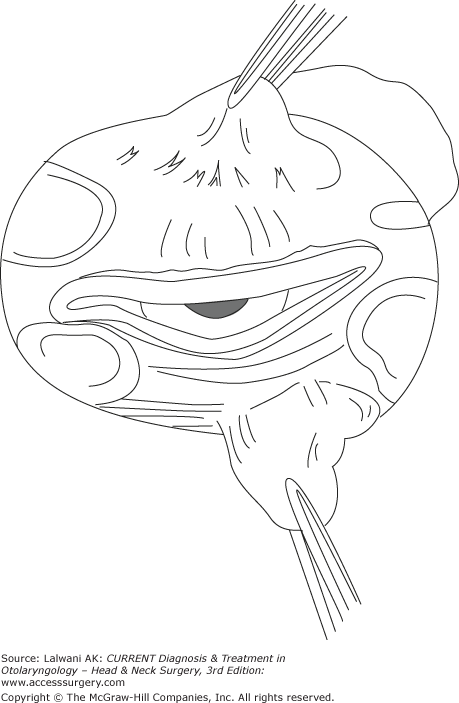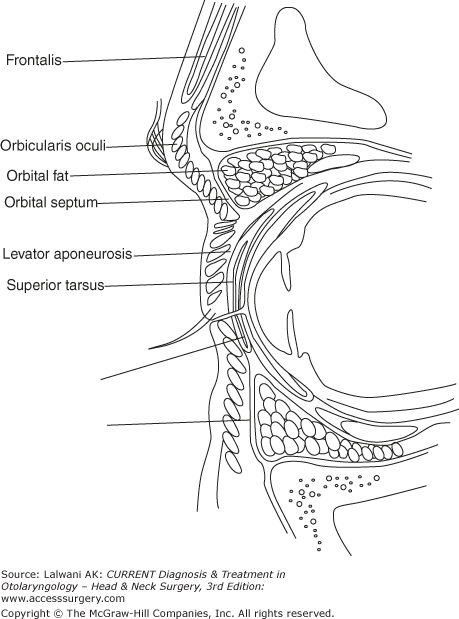Anatomy
Eyelid skin is the thinnest in the body with relatively sparse subcutaneous fat. This allows free movement of the lid in closure and blinking. The upper eyelid skin is thinner than that of the lower lid. The skin itself has many fine hairs as well as sebaceous and sweat glands. Healing occurs quickly in this area and scarring is usually minute.
The lid crease of the upper eyelid is formed by the insertion of the levator aponeurosis fibers into the skin and the orbicularis oculi muscle. It is approximately 8–12 mm superior to the lash line and lies just at the level of the upper edge of the tarsal plate. Medially and laterally, the crease is closer to the lid margin and has an arc shape across the lid. The Asian eye usually lacks this crease due to the lower insertion of the levator aponeurosis on the tarsus.
The lid fold describes the tissue above the lid crease and may extend throughout the length of the upper lid or it may be more localized. Excess tissue may develop in the aging face and sag over the lid crease, sometimes obscuring vision. A combination of excess skin, hypertrophied orbicularis oculi muscle, and herniated fat can be responsible for this process.
The orbicularis oculi muscle provides the main mimetic function to the eyelid. It receives its innervation from the temporal and zygomatic branches of the facial nerve. The muscle is elliptical and divided into three bands (the pretarsal, preseptal, and preorbital), which attach to the bony orbit at the medial and lateral canthal tendons. The muscle can become hypertrophied over time and result in a full appearance of the eyelids.
Orbital fat cushions the globe and its associated structures, and its anterior limit is the orbital septum. In the upper eyelid, the fat separates the levator aponeurosis posteriorly and the orbital septum anteriorly. Here it is divided into two fat compartments: central and medial. In the lower lid, there are three fat compartments: lateral, central, and medial (Figure 74–1).
Levator Palpebrae Superioris Muscle
The levator muscle acts to elevate the upper eyelid and has its origin in the periorbita posteriorly. The muscle runs above the superior rectus and fans out anteriorly to become the levator aponeurosis. Insertion occurs at the level of the tarsus, as previously described, forming the lid crease (Figure 74–2). Its innervation is by cranial nerve III (the oculomotor nerve).
The tarsi are composed of fibrous tissue and provide the general shape and firmness to the eyelids. The upper and lower tarsi measure approximately 10 and 5 mm in height, respectively. Many meibomian glands are present in both tarsi and open into the ciliary margin.
This mucus membrane is attached to the tarsal plate and covers the tarsus and Muller muscle. Due to its firm tarsal attachment, the conjunctiva does not have to be sutured following incision. The gray line marks the border between the conjunctiva and skin. Histologically, there is columnar epithelium posteriorly and stratified squamous epithelium anteriorly. This landmark is frequently used in eyelid surgery.
Preoperative Assessment
A thorough history and physical, especially an ophthalmologic history, should be performed on every patient. Schirmer testing will help screen patients who are prone to dry eye postoperatively. The snap test allows for the determination of the laxity of the lower lid skin. The lower lid is pulled away from the globe and its snap back to the normal position is observed. If the lid is slow to snap back, lower lid laxity is a concern and the patient may be at risk for postoperative ectropion. A full-thickness shortening of the horizontal lid can help prevent this complication at the time of blepharoplasty.
Close attention to any degree of scleral show should be made; scleral show occurs when the lid margin does not reach the cornea. Also, any asymmetries should be documented and discussed with the patient. Patients with proptosis are poor candidates for blepharoplasty because of the risk of lagophthalmos and ectropion. In addition, blepharoplasty in patients found to have dry eye should be done very conservatively.
Aspirin should be discontinued at least 2 weeks before and after surgery to decrease the risk of bleeding. Preoperative photography is mandatory and involves the frontal view with eyes open, closed, and in upward gaze; a lateral view should also be taken. These photographs are reviewed with the patient and realistic goals and limitations are discussed.





